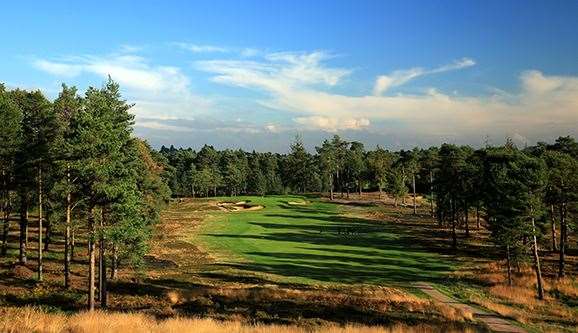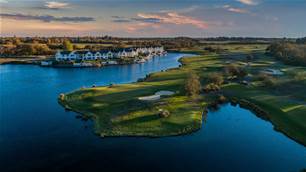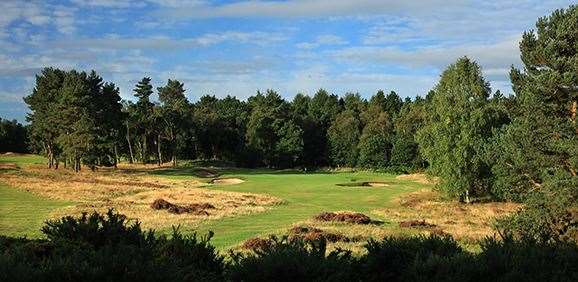Mike Clayton says there are valuable lessons to be learned about the design and set-up of British courses, particularly the use of trees.
Golf in Britain is always a treat and something anyone remotely interested in the game beyond the superficial should experience at least once in their lives.
Some head simply to the famed Open Championship courses, pay extortionate green fees and tick them off the list of things they need to see and do. Others search out the lesser-known gems liberally sprinkled all over the place and the reward is finding the best reasonably accessible golf in the world.
 There are two Herbert Fowler-designed courses at The Berkshire, south-west of London.
There are two Herbert Fowler-designed courses at The Berkshire, south-west of London.PHOTO: David Cannon/Getty Images.
Sure America has places like Pine Valley, Shinnecock Hills, The National, Sand Hills and Augusta National but unless you’re willing to sell your eldest child, getting a game is next to impossible.
The Open courses are all worth seeing, St Andrews especially, but I’d rather play four rounds at Notts or Ganton or Brora than one at Turnberry or Troon or St George’s.
I was over with Ashley Mead (the M in OCCM Golf) for The Open at St Andrews followed by a week winding down through the country to the London Heathlands. I then headed back across the border to Turnberry for the British Women’s Open and a caddieing assignment for surely the easiest autograph in sport, Su Oh.
We saw a lot in three weeks, beginning with our arrival coinciding with the final day of the Scottish Open at Gullane. Gullane is a really good seaside course and an ideal venue for a big European Tour event but it competes with Muirfield just up the road and the remarkable North Berwick only 15 minutes further away. Rickie Fowler won in Gullane with a final-hole birdie but the line of the week came from Phil Mickelson’s son.
Early in the week Mickelson was on the 7th tee high up on Gullane Hill looking down over Muirfield. “All the greats have won down there,” he announced to 13-year-old Evan.
“Then you must be the exception,” the boy replied.
No one laughed harder than Mickelson.
North Berwick is a throwback to a time when the game was wild, there was no convention, ‘fairness’ was not a word associated with golf and no one found a particular virtue in counting every shot. They played matches against each other over perfect terrain for golf. There are blind shots, blind hazards, greens which would now be considered crazy, a couple of shots over stone walls and a finishing hole bordering a busy neighborhood street with the attendant parked cars and houses. What you won’t find are people moaning about the occasional ball hitting something. ‘The golf course was here first’ is the attitude of the locals.
The Open is the game’s greatest event. It’s played over the best test of golf made so by great design, perfect turf to hit shots off, ground which demands players judge the bounce and use it to get the ball to the target. The conditions over the opening three days (including the whole of Saturday it took to finish up the second day) where brutal but it’s long been said, if golf needed sun it wouldn’t have been invented in Scotland.
Marc Leishman added his name to those of Jack Newton, Wayne Grady, Greg Norman, Stuart Appleby and Steve Elkington as Australians vanquished in an Open play-off. In retrospect the holes chosen may have been convenient but three of them – 1, 2 and 18 – are drive and pitch holes. Only the 17th requires the execution of a great long shot and Zach Johnson whiffed the long approach into the 17th green, while Louis Oosthuizen hit a beautiful iron on to the green only to be done in by a three-putt. It was too big a mistake to make at the time but The Open confirmed the South African as one of the most technically perfect players ever to play the game.
From St Andrews we drove respectively to Alwoodley, Ganton, Notts and Royal Worlington, the best nine-hole course in the world.
Alwoodley is the 1907 creation of Alister MacKenzie and as a consequence one of the most important courses in the game. It is set near Leeds in the middle of England and being inland, trees are an important part of the ambience of the golf.
People think we hate trees and it’s true. We do hate trees … trees that cramp courses, block views better opened, ruin what otherwise might be good holes and trees that belong in another state or, worse, another country.
Having walked those four tremendous courses, can someone explain to me why neither Ashley nor I could find a single tree we would suggest cutting down?
The answer is simple and obvious. The English understand the proper role of trees in golf. On inland sites they are a part of the golf but as Harry Colt once said “a part of the scenery but not a part of the stage”. It’s a pity we in Australia have generally not learned the lesson. There are exceptions but find me four courses here where it would be impossible to find an intruding or inappropriate tree. Even Royal Melbourne has one.
Any proper golf trip to England is not complete unless you have visited at least two of the four courses on the path down from St Andrews to Sunningdale.
The heathlands south and west of London has probably the finest collection of courses in the world. New York and Philadelphia too, are world-class as obviously is the Melbourne Sandbelt, but for pure numbers of first-class courses it’s hard to surpass London. In our two days we walked the two courses at The Berkshire, Woking, Swinley Forest and the Old and New courses at Sunningdale.
Swinley Forest, just up the A30 from Sunningdale, was described by Colt as his “least bad course”. Clearly not a believer in the employment of self-promotion, he made an incredible course in the Swinley Forest.
It was 6,000 yards for the longest time but matching its par of 68 took great golf because of the composition of the holes, including surely one of the handful of courses with a claim to the best set of par-3s in the game.
They have some back tees now and despite its lack of modern length it is a big sprawling course with the requirement to hit a lot of good shots. Geoff Ogilvy calls it his favourite course in golf, “Because I can play with my dad and we can both have a great day.”
Turnberry was a difficult test made by a continuation of the awful weather the men ran into at St Andrews. Su made the cut, played only decently on the weekend and finished a way behind the remarkable Inbee Park. She has dominated the women’s majors these past couple of seasons and despite Stacy Lewis’ observation that Korean women “practise ten hours a day”, Park barely hits a practice ball.
“She did practise a bit at Turnberry,” said So Yeon Ryu’s caddie Tom Watson, “but nine out of ten weeks she does nothing.”
Turnberry is probably the weakest of the Open courses and three days after Park holed out, Donald Trump began blowing up the course and remaking it. His plan is to make more of the holes on the ocean and on paper at least it looks likely he will make something better.
Finally came Prestwick, not far up the road from Turnberry. The first dozen Open Championships were played over this links and it is one of the game’s most remarkable places. It is wild, crazy in parts, a mix of conventional and the quirkiest of quirky topped off by the incredible Alps Hole – the par-4 17th. Anyone who thinks the 17th at Kingston Heath is somehow a bad or unfair hole needs to see the 17th at Prestwick. One is a really good hole and the other is one of the great holes in the game and both are made by a blind approach. At Prestwick, the approach is not only blind but must carry the famous Sahara bunker.
 Prestwick’s hidden and protected 17th green confounds at first but is enthralling once discovered.
Prestwick’s hidden and protected 17th green confounds at first but is enthralling once discovered.PHOTO: Brendan James
It sums up the greatest lesson of British golf. Never should we try to sanitise the game, make it ‘fair’ or playable for even the poorest golfers who have so little respect for the game they cannot even be bothered to learn a proper grip.
MIKE CLAYTON is Australia’s most outspoken columnist and an acclaimed course designer with Ogilvy Clayton Cocking Mead Course Design (www.occmgolf.com). His column appears monthly in Golf Australia magazine.
Related Articles

Review: Clearwater Golf Club

Review: Omaha Beach Golf Club















